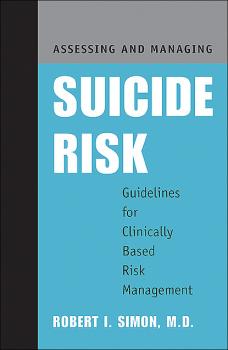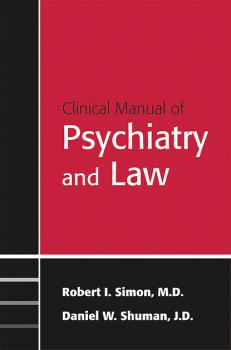Robert I. Simon
Список книг автора Robert I. SimonPreventing Patient Suicide
Today's psychiatrists practice in an environment that poses difficult challenges. Both treatment time and duration are limited by insurance requirements; many facilities are understaffed; split treatment arrangements are typical; and high-risk, acutely suicidal patients are admitted to inpatient units for short lengths of stay. In addition, law now plays a pervasive role in the practice of psychiatry. The doctor-patient relationship is no longer defined solely by the involved parties. Clinicians must juggle these requirements and limitations while providing the very best care to their patients, especially those at high risk.Preventing Patient Suicide: Clinical Assessment and Management provides the wisdom of Dr. Robert I. Simon's vast clinical experience, combined with the latest insights from the evidence-based psychiatric literature, to offer a cutting-edge survey of suicide prevention and management techniques. The author: Addresses sudden improvement in high-risk suicidal patients, a phenomenon both common and perilous, with techniques for determining whether the improvement is real or feigned. Explores in depth the misuse of suicide risk assessment forms, with emphasis on their inherent limitations. Examines the many entrenched myths and traditions about suicide, exposing them to the critical light of evidence-based medicine, including the concept of «imminent suicide risk» and the myth of «passive suicide ideation». Discusses the continuum of chronic and acute high-risk suicidal patients, the fluidity with which one can become the other, and the difficulty in assessing these patients. Explores how the law and psychiatry interact in frequently occurring clinical situations, and the importance of therapeutic risk management. In addition, the book contains a variety of features that illuminate the subject and enhance the reader's understanding, including: Inclusion of illustrative case studies, combined with commentary on commonly occurring but complex clinical situations. Key points at the end of each chapter that identify critical information. A Suicide Risk Assessment Self-Test, a teaching instrument that consists of fifty questions designed to enhance clinician suicide risk assessment by incorporating evidence-based risk and protective factors. Dr. Simon provides a nuanced, empathic, yet pragmatic perspective on identifying, assessing, and managing the suicidal patient while successfully navigating a complex legal and clinical environment that poses its own risks to the practitioner.
Bad Men Do What Good Men Dream
Robert Simon's Bad Men Do What Good Men Dream: A Forensic Psychiatrist Illuminates the Darker Side of Human Behavior is that rare title that is both essential reading for the mental health professional and accessible in style and content to the fascinated lay reader. In twelve powerful and provocative chapters, the author introduces readers to a psychological perspective on evil, character and destiny, as well as the making of good men and women. Simon also illuminates the psychology of psychopaths, serial killers, rapists and all manner of evil characters who appall and challenge us by their very existence. He rejects the common belief that his subjects are «monsters» with nothing in common with the more «normal» among us. Simon posits that if we deny our dark side, it can only obscure our understanding of violent offenders and impede our ability to both know ourselves and control our own, at times, unacceptable impulses.The author is among the foremost experts in forensic psychiatry. He is Director of the Program in Psychiatry and Law at Georgetown University School of Medicine. Author or co-author of more than two dozen books and editions, including the foundational Textbook of Forensic Psychiatry, Simon has made important contributions to the field of forensic psychiatry for more than 30 years. He is also an eloquent writer with a dramatic, yet nuanced, narrative style that takes the reader inside the mind of the evildoer.The first edition of this groundbreaking work garnered uniformly superlative reviews and was translated into several languages. This updated version retains Simon's engrossing portrayals and keen insight, while offering a number of key enhancements. The highlights include: Explorations of the Internet and violence, «corporate» psychopaths, cyberstalkers, perpetrators of school violence, and a new cast of serial killers, terrorists, and other evildoers. A psychological perspective on evil, serial killers, and us. Updates on the neuroscience and genetics of deviant behaviors. Reflections on empathy, character, and destiny: the making of good men and women. A new foreword by Thomas G. Gutheil, M.D., Professor of Psychiatry and Co-Founder, Program in Psychiatry and the Law at Harvard Medical School, that illuminates Simon's thesis and grounds it in historical context. Graphic but never sensational, unsparing but never cold, Simon's writing transcends the theoretical and achieves that most difficult of aims: leading readers to discover, contain, and transform the darkness within us all, to the betterment of our human condition.
Assessing and Managing Suicide Risk
Patient suicide is an unavoidable occupational hazard of psychiatric practice. Indeed, it is the rare clinician who does not struggle, even agonize, over the complex task of assessing and managing the risk of suicide in patients. Patient suicides account for the greatest number of malpractice suits filed against psychiatrists and for the greatest number of settlements and verdicts covered by professional liability insurers.In this book, written by a clinician for clinicians, Dr. Simon, an established expert in psychiatry and law, offers A solid, easy-to-understand review of how medical malpractice law applies to patient suicides. He discusses the standards of care physicians must meet, the conditions associated with malpractice liability, and how best to minimize risks of litigation. Extensive references to peer-reviewed literature on suicide and recent malpractice cases, including those triggered by patient suicides, which give insight into the latest developments in both the scientific community and the courts. Much-needed practical advice, including advice on working with suicide risk assessments and suicide prevention contracts, on treating suicidal patients in various settings (outpatient, inpatient, collaborative, and emergency), and on coping with issues arising in the aftermath of a patient's suicide (documentation, confidentiality, and survivor care). Clearly defined risk management guidelines that will help clinicians avoid litigation or establish a sound legal defense if sued for malpractice. Numerous case examples that make the theoretical discussions and clinically based risk management guidelines that follow come alive. Rich in advice that draws on the author's more than 40 years of clinical experience, this book serves as an essential aid to clinicians.
Clinical Manual of Psychiatry and Law
In their latest collaboration, Clinical Manual of Psychiatry and Law, noted forensic psychiatrist Dr. Robert Simon and legal scholar Daniel Shuman, both recipients of the Guttmacher Award, have created a unique, practical reference to enable psychiatrists to transform the impact of the law on their clinical practices from an adversary to a working partner. In lieu of scare tactics or horror stories, Dr. Simon and Professor Shuman clearly explain not only what the law requires and why but how best to integrate its requirements to enhance clinical practice and reduce the risk of successful tort claims. They have written a clear, comprehensible, and accessible volume that will guide practitioners through the thickets of the law and benefit their clinical practices.This volume covers a wide range of topics, from confidentiality, privilege, informed consent and the right to refuse treatment to treatment boundaries, involuntary hospitalization, seclusion and restraint, management of violent as well as suicidal patients, and the additional requirements which apply to the treatment and evaluation of minors or persons with mental disabilities. It also includes the tort (i.e., negligence, intentional harm) claims that arise from a breach of the law's expectations. The content reflects the latest legal precedents concerning such topics as: Establishment of the doctor-patient relationship and liability for damages caused by its breach, including new rulings governing confidentiality and testimonial privileges Case law regarding informed consent – especially the issue of competency when dealing with minors or persons with mental disabilities New rules and regulations restricting the use of seclusion and restraint Guides to the most recent laws regarding involuntary hospitalization and emergency commitment Insights into recent state court decisions concerning disclosures by therapists of threats of harm by patients against others, including such issues as conflicts between the duty to maintain confidentiality and the duty to protect Reviews of recent legislation proscribing sexual misconduct or prosecuting sexual exploitation of patients under existing rape or sexual assault laws Clinicians will find this wealth of knowledge immediately practical and lawyers will appreciate its in-depth treatment of complex psychiatric issues. With extensive references and a glossary of legal terms, Clinical Manual of Psychiatry and Law deserves a place among the top legal references for mental health professionals.



